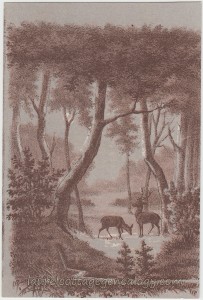Trade card, circa 1898 – 1908. Size: About 3 and 3/8 x 5″ Condition: Poor with folds, tape and some staining.
Price: $4.00
Since we were in Detroit for the last two posts, this one had to be next for the following two reasons: Lilies of the valley always remind me of my hometown; we had them in the backyard when I was growing up. And we just passed the month of April, and April in the D is often subjected to that one last snow or ice storm. Ha, yep, was it a week or two ago when the Tigers were playing in 38 degrees and snow flurries? So, I’m not lying! But what a beautifully designed trade card for the W. M. Hoyt Company. There’s a small lake in winter, with the dawn reflecting yellow off the water, the trees showing bare and the ground still covered with snow. But inserted through the side of this tableau is a promise of spring: a small offering of lilies of the valley with their leaves, and a small sprig and leaf showing from underneath on the opposite side. If you didn’t notice right away, look again and you’ll see the pin drawn in at the top of the “paper.” And one thing that we’re getting used to noticing (but is always wonderful) is how the shadows are carefully drawn or painted in. The back shows, in part:
“W. M. Hoyt Company, Proprietors Fort Dearborn Coffee and Spice Mills, Nos. 1 to 11 Michigan Avenue, Chicago.”
“Why you should buy Hoyt’s Standard Coffee.”
“Because of its flavor delicious and sweet,
Because of its strength, which none can beat.
Because it is fresh, healthful and sound,
Because of its cheapness, its goodness and worth
Because ’tis the best for the money on earth.”
W. M. Hoyt Co. with an address of 1 Michigan Ave in Chicago, shows up on the 1908 commercial city directory, under the heading of Grocers – wholesale.
But the 1898 city directory reveals more information: The W. M. Hoyt Co. was William M. Hoyt, president; Robert J. Bennett, vice-president; Arthur G. Bennett, secretary and treasurer; Albert C. Buttolph and Graeme Stewart directors. Address 1 – 11 Michigan Ave, and 1 – 9 River Ave.
Sources: The Chicago Association of Commerce’s Membership Directory, June 1908, p. 115. (Ancestry.com. U.S. City Directories, 1821-1989.)
The Lakeside Annual Directory of the City of Chicago, 1898, p. 873. (Ancestry.com. U.S. City Directories, 1821-1989.)

























